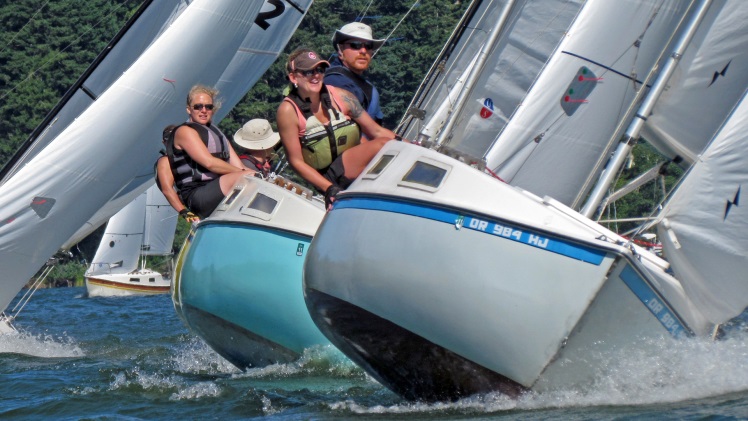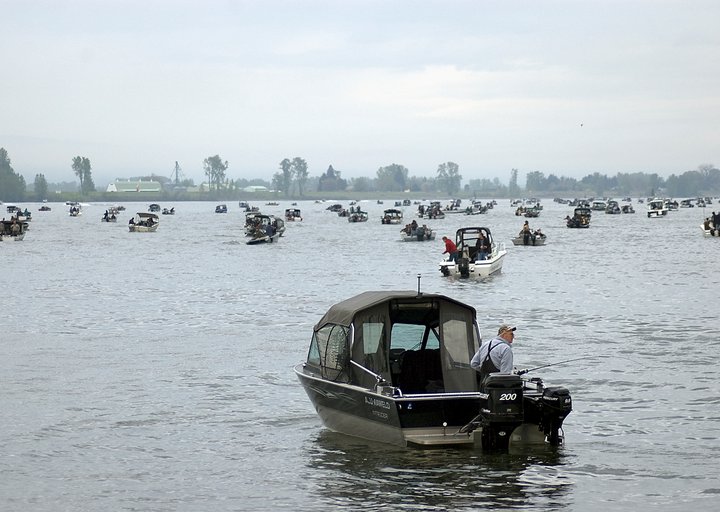A Reference Guide for Recreational Boats
The Navigation Rules of the Road apply to all boats on U.S. navigable waters as defined or designated under 33CFR 2.05 - 25. This is a summary only, and on all U.S. navigable waters, all boaters must comply with the Rules in their entirety. These rules are enforced by marine law enforcement under OAR 250-011-0020 to 250-011-0020.
APPLICATION (Rule 1)

These rules apply to all vessels upon the inland waters of the United States and to vessels of the United States. The word "vessel" includes every description of watercraft, including non-displacement craft, and seaplanes used or capable of being used as a means of transportation on the water. This is commiserated with Oregon's definition of a boat.
RESPONSIBILITY (Rule 2)
None of the Rules shall exonerate any vessel, or the owner, master, or crew thereof, from the consequences of any neglect to comply with these Rules or of the neglect of any precaution which may be required by the ordinary practice of seamen, or by the special circumstances of the case.
In using these Rules, be aware of all dangers of navigation and collision and to any special circumstances, including the limits of boats involved, which may require a departure from these Rules necessary to avoid immediate danger.
LOOK-OUT (Rule 5)
Every vessel shall at all times maintain a proper look-out by sight and hearing as well as by all available means appropriate in the prevailing circumstances and conditions so as to make a full appraisal of the situation and of the risk of collision.
SAFE SPEED (Rule 6)
Every vessel shall at all times proceed at a safe speed so that she can take proper and effective action to avoid collision and be stopped within a distance appropriate to the prevailing circumstances and conditions. In determining a safe speed, the following factors shall be among those taken into account by all vessels:
-The state of visibility;
The traffic density, including concentrations of fishing vessels or any other vessels;

-The maneuverability of the vessel with special reference to stopping distance and turning ability in the prevailing conditions;
-At night, the presence of background light,s such as from shore lights or from backscatter from her own lights;
-The state of wind, sea, and current, and the proximity of navigational hazards;
-The draft in relation to the available depth of water.
RISK OF COLLISION (Rule 7)
Every vessel shall use all available means appropriate to the prevailing circumstances and conditions to determine if a risk of collision exists. If there is any doubt, such risk shall be deemed to exist. In determining if risk of collision exists, the following considerations shall be among those taken into account:
-Such risk shall exist if the compass bearing of an approaching vessel does not appreciably change.
-The risk may sometimes exist even when an appreciable bearing change is evident, particularly when approaching a very large vessel or when approaching a vessel at close range.
ACTION TO AVOID A COLLISION (Rule 8)
- Any action to avoid collision shall be taken in accordance with the Rules of this subpart and shall if the circumstances of the case admit, be positive, made in ample time and with due regard to the observance of good seamanship.
- Any alteration of course and/or speed to avoid collision shall, if the circumstances of the case admit, be large enough to be readily apparent to another vessel observing visually or by radar; a succession of small alterations of course and/or speed should be avoided.
 If there is sufficient sea room, alteration of course alone may be the most effective action to avoid a close-quarters situation provided that it is made in good time, is substantial and does not result in another close-quarters situation.
If there is sufficient sea room, alteration of course alone may be the most effective action to avoid a close-quarters situation provided that it is made in good time, is substantial and does not result in another close-quarters situation.
- Action taken to avoid collision with another vessel shall be such as to result in passing at a safe distance. The effectiveness of the action shall be carefully checked until the other vessels are finally past and clear.
- If necessary to avoid a collision or allow more time to assess the situation, a vessel may slacken her speed or take all way off by stopping or reversing her means of propulsion.
- A vessel which, by any of these Rules, is required not to impede the passage or safe passage of another vessel shall, when required by the circumstances of the case, take early action to allow sufficient sea room for the safe passage of the other vessel.
NARROW CHANNELS (Rule 9)
A vessel proceeding along the course of a narrow channel or fairway shall stay near the outer limit of the channel or fairway, which lies on her starboard side, as is safe and practicable.
A vessel of less than 20 meters in length or a sailing vessel shall not impede the passage of a vessel that can safely navigate only within a narrow channel or fairway.
Any vessel shall, if the circumstances of the case admit, avoid anchoring in a narrow channel (e.g., the Columbia River during fishing seasons when commercial vessels transit).
Rule 9, when it comes to the operation of non-motorized vessels in areas where there is restricted space and a heavy concentration of boaters, Rule 9 would also apply: Stay to the right of the channel. Cross the channel at right angles with due regard to the other traffic transiting the channel. If you are unsure of the other vessel's intentions, sound five short blasts of a horn or whistle. The only exceptions to these rules would be if the vessels were operating in a marine event permitted by the Coast Guard but realize that even in that situation if a risk of collision exists, always revert to the rules.
OVERTAKING (Rule 13)

A vessel overtaking any other shall keep out of the way of the vessel being overtaken.
A vessel shall be deemed to be overtaking when coming up with another vessel from a direction more than 22.5 degrees abaft her beam; that is, in such a position with reference to the vessel she is overtaking, that at night she would be able to see only the stern light of that vessel but neither of her sidelights.
Be prepared to use sound signals to indicate intentions.
A vessel shall be deemed to be overtaking when coming up with another vessel from a direction more than 22.5 degrees abaft her beam, that is, in such a position with reference to the vessel she is overtaking, that at night she would be able to see only the stern light of that vessel but neither of her sidelights.
When a vessel is in any doubt as to whether she is overtaking another, she shall assume that this is the case and act accordingly.
HEAD-ON SITUATION (Rule 14)

When two power-driven vessels are meeting on reciprocal or nearly reciprocal courses so as to involve risk of collision, each shall alter her course to starboard so that each shall pass on the port side of the other.
Such a situation shall be deemed to exist when a vessel sees the other ahead or nearly ahead, and by night she could see the masthead lights of the other in a line or nearly in a line and/or both sidelights, and by day she observes the corresponding aspect of the other vessel.
When a vessel is in any doubt as to whether such a situation exists, she shall assume that it does exist and act accordingly.
CROSSING SITUATION (Rule 15)
When two power-driven vessels are crossing so as to involve risk of collision, the vessel which has the other on her own starboard side shall keep out of the way and shall, if the circumstances of the case admit, avoid crossing ahead of the other vessel.
ACTION BY GIVE-WAY VESSEL (Rule 16)

Every vessel that is directed to keep out of the way of another vessel shall, so far as possible, take early and substantial action to keep well clear.
ACTION BY STAND-ON VESSEL (Rule 17)
Where one of two vessels is to keep out of the way, the other shall keep her course and speed.
The latter vessel may, however, take action to avoid collision by her maneuver alone, as soon as it becomes apparent to her that the vessel required to keep out of the way is not taking appropriate action in compliance with these Rules.
When, from any cause, the vessel required to keep her course and speed finds herself so close that collision cannot be avoided by the action of the give-way vessel alone, she shall take such action as will best aid in avoiding collision.
RESPONSIBILITY BETWEEN VESSELS (Rule 18)
Except where Rules 9, 10 (compliance with official traffic separation schemes), and 13 otherwise require, the higher-listed vessels shall keep out of the way of the lower-listed vessels:
A power-driven vessel underway shall keep out of the way of:
-A vessel not under command;*
-A vessel restricted in her ability to maneuver;**
-A vessel engaged in fishing;***
-A sailing vessel (under sail only)
A sailing vessel shall keep out of the way of:
-A vessel not under command;
-A vessel restricted in her ability to maneuver, and;
-A vessel engaged in fishing;
A vessel engaged in fishing when underway shall, so far as possible, keep out of the way of:
-A vessel not under command, and;
-A vessel restricted in her ability to maneuver.
CONDUCT OF VESSELS IN RESTRICTED VISIBILITY (Rule 19)
When vessels are not in sight of each other when operating in or near an area of restricted visibility, every vessel shall proceed at a safe speed adapted to the prevailing circumstances and conditions of restricted visibility. A power-driven vessel must have her engines ready for immediate maneuver.
Every vessel shall have due regard to the prevailing circumstances and conditions of restricted visibility when complying with Rules 4 through 10.
A vessel that detects by radar alone the presence of another vessel shall determine if a close-quarters situation is developing and/or a risk of collision exists. If so, the vessel shall take avoiding action in ample time, provided that when such action consists of an alteration of course, so far as possible, the following shall be avoided:
- An alteration of course to port for a vessel forward of the beam, other than for a vessel being overtaken.
- An alteration of course toward a vessel abeam or abaft the beam.
Except where it has been determined that a risk of collision does not exist, every vessel that hears forward of her beam the fog signal of another vessel, or which cannot avoid a close-quarters situation with another vessel forward of her beam, shall reduce her speed to the minimum at which she can be kept on course. She shall, if necessary, take all her way off and, in any event, navigate with extreme caution until the danger of collision is over.
*The term "vessel not under command" means a vessel that, through some exceptional circumstance, is unable to maneuver as required by these Rules and is unable to keep out of the way of another vessel.
**The term "vessel restricted in her ability to maneuver" means a vessel which, from the nature of her work, is restricted in her ability to maneuver as required by these Rules and is, therefore, unable to keep out of the way of another vessel.
***The term “vessel engaged in fishing" means any vessel fishing with nets, lines, trawls, or other fishing apparatus that restricts maneuverability, but does not include a vessel fishing with trolling lines or other fishing apparatus that do not restrict maneuverability.